A couple of years ago, Il Sole 24 Ore, a distinguished Italian financial newspaper, wrote a story about MagneticDays, and how it all started in a garage in a small Tuscan village in the Arezzo province. Here, in the late 80’s, a group of friends came up with the idea of building an experimental plane, the GLASAIR, which ended up being an actual flying and functioning plane. All passionate about experimenting and engineering by hobby, most artisan goldsmiths by trade, they all put their efforts together to create new things. They also shared another passion: cycling. So after the plane was completed they started thinking about something new to build; this is how MagneticDays came about: “My true passion is the mechanics of flying – says the CEO of Orf and MagneticDays Marco Sbragi – and Orf is one of the oldest goldsmith companies in the region. It was founded many years ago by my father Giuseppe (born in 1918) who started working as a goldsmith when he was 7 years old. We have always exported a large part of our production: necklaces, bracelets, earrings. Our mechanics department is extremely important, as making our products requires the utmost precision. This is the reason – continues Marco Sbragi – we wanted to realize something that represented both the present and the future of our adventure, without forgetting our roots.”
The new line of jewelry signed MagneticDays celebrates cycling in all its forms and was born as a trait d’union between the goldsmith art and the MD technology. The launch is a also a way to thank all the friends who are participating in the 40 episodes of MD LIVE TRAINING, the indoor cycling format created by MagneticDays to link up customers and friends during these hard months of restrictions due to Covid, and to reinforce the sense of community that MD built in the 10 years from its birth. The team is made of bikers, mtbikers, triathletes, runners, canoeists, bobsledders, all united by the motto “I am Magnetic”!
MagneticDays Jewelry is available now on our e-commerce and includes two lines: FLY-WHEEL – dedicated to the lovers of speed – and SPROCKET SET, dedicated to the lovers of pure mechanics. Both lines can be personalized with the customer’s name upon request, and are available as necklace, bracelet or keychain. You can also choose between the MD steel chain and drawstring. Available in four colors, between the present and the future of the JARVIS: red, black, electric blue and smooky grey.
But there is more: for each purchase of jewelry you will enjoy a 25% of the total price. This amount can be used within 30 days from the purchase in two ways: deducted from the first installment of SMART RENT or from the purchase of any MD self managed Workout package.
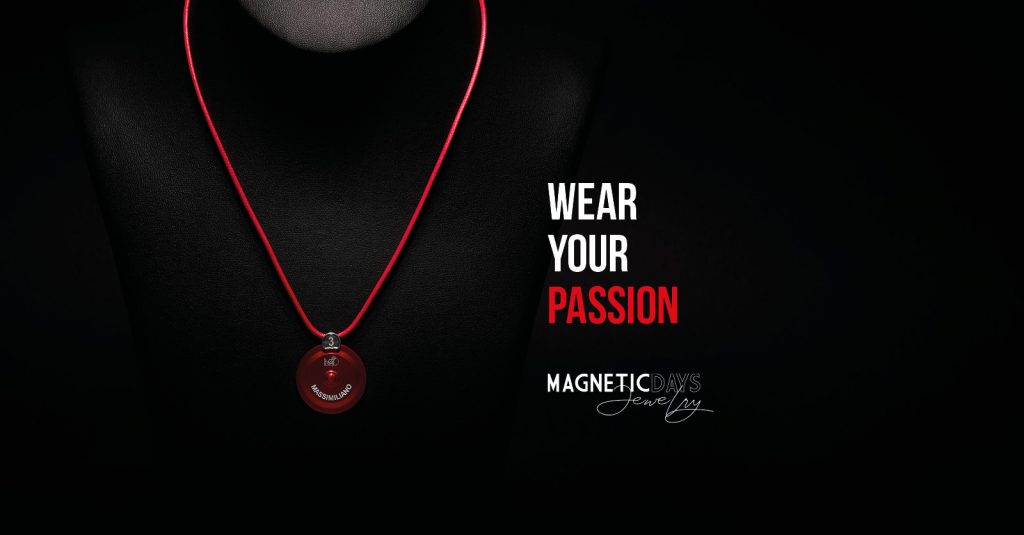
2021 has just begun and it’s already time for new challenges for MagneticDays. The latest one is to face and conquer the US market of home and indoor training. The Italian company has expanded its horizons by opening a new branch in Tampa, FL. with a US based team. “Indoor cycling, especially in the States, has become an integral part of many training programs – says Marco Sbragi, MD CEO – and this is why we decided to invest in this market, selecting experienced personnel coming from the world of cycling and triathlon.”
MagneticDays has a brand new American website where you can get the smart trainer JARVIS (you can either purchase one or rent it for 3 or 6 months), but you can also find other neat things, like branded training mats, stabilizing roll bars, phone/tablet holders and a bunch of HTT (High Tech Training) training packages, which are all for sale on line.
“Seeing that the American market has responded to a ‘testa rossa without wheels’ with such enthusiasm gives us joy – says the US team – and we are happy to recognize that MagneticDays’ products have an incredible aesthetic and technological appeal. When we talk about ‘Made in Italy’, especially in the cycling world, we always refer to something that inspires feel-good emotions. We know that Americans love beautiful and well-made products, and MagneticDays means high technology combined with top Italian quality. This is why we are confident the US branch will develop exponentially. We, as US team, are ready and eager to contribute to boost the well-being and performance of each and every person who will decide to start using the indoor training system JARVIS.”
New official ANT+ Heart Rate Monitor and Cadence Sensor by MagneticDays are now available to buy on MD shop online. All of clients who want to access to the MagneticDays JARVIS smart bike trainer through one of the 5 available ways, will find these two accessories already equipped with batteries inside the iconic wooden box. And that’s not all! We will also add an additional pack of batteries (2 pieces, CR 2032 lithium model) in the package for free.
The compatibility of BLUETOOTH® 5.0 wireless technology and the presence of a sensor that will be used for future implementations of physiological studies and responses during indoor cycling, are among the main features of the new official ANT+ Heart Rate Monitor: “With our scientific and 100% customized methodology of training, we demonstrate to love science and innovation for training every day – the MD CEO Marco Sbragi said – walking side by side of specificity and scientific nature of our identity. Indeed, the future of our research is focused on the personal data collection for each user/athlete (in accordance with GDPR) aimed at favoring our research and experimentation on new training protocols.”

Amongst the latest news introduced by MagneticDays we discover the possibility for the athlete to write their own indoor cycling training sessions on the JARVIS smart trainer. This feature is exclusive of MagneticDays. Having received many requests, we want to tell you more about writing your own training sessions, and we’ll get into details about your personal indoor cycling training tables and how to transform a simple smart training session into a unique experience.
The HTT methodology for indoor cycling on smart trainers
The HTT methodology can guarantee a personalized indoor cycling training on smart trainers for anybody. It is, in fact, the only one that gives the coach a precise picture of the characteristics of each athlete at any given moment. The relationship between coach and athlete is fundamental. The coach has to understand the athlete’s needs and goals, and, at the same time, share their fears, dreams and ambitions. On the other hand, the athlete has to trust the knowledge and professional experience of the coach, who represents the added value to an already unique product as the JARVIS. We decided to give our athletes the possibility to write their own workouts by offering a base framework which includes many of the writing options and tools that coaches use. Let’s see what it’s all about.
How to write an indoor training table for the smart trainer JARVIS
Every athlete who is registered on our website can write their own indoor cycling training table by accessing their MagneticDays account. Before this option was available (end of 2018) you needed to access the MD software downloaded on your PC to be able to write your own sessions. We figured it might be inconvenient at times, so we decided to add another option. Once you are logged on in your personal profile (user ID and password are the same as for the App) click on “write workout”. You will see a writing interface, as shown below.
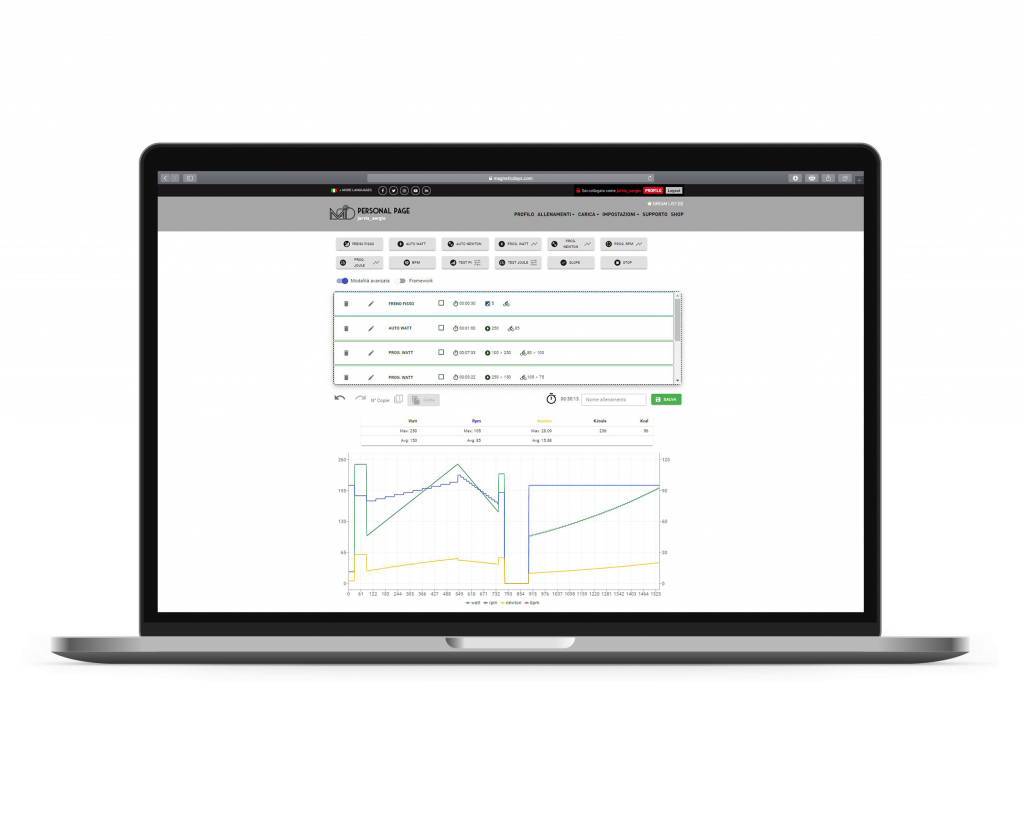
How many, and what are the ways of writing workouts provided by MagneticDays?
There are two ways of writing workouts provided by MagneticDays: Standard Training and Frameworks. Here’s what they are in detail.
- Standard Training: this allows you to write workouts by inputting absolute values (for example: 90 Watts, 50 Newton, 100 RPM);
- Framework (fee): lets you use the functions that coaches use, including percentages and OFFSET of the threshold.
Writing workouts in “Standard Training” mode
In the “Standard Training” mode you can use the following parameters:
- AUTO WATT– the Watts are the fixed value, they do not change.
- AUTO NEWTON– only athletes who know their cadence value and Watts will use this step, specifically to train the force.
- WATTS PROGRESSION– classic Watts progression, for example, during warm up, in the middle of the training or as Watts regression during cool down.
- RPM PROGRESSION – classic RPM progression
- BPM– this parameter lets you chose the heart rate at which you want to execute each step*
- SLOPE – lets you write a course with a slope
- FIXED BRAKE – 30 brake positions, from 1 to 30, from lightest to heaviest**
*use this for long steps so that the heart rate can physiologically adapt
**to use synergically with the bycicle gears
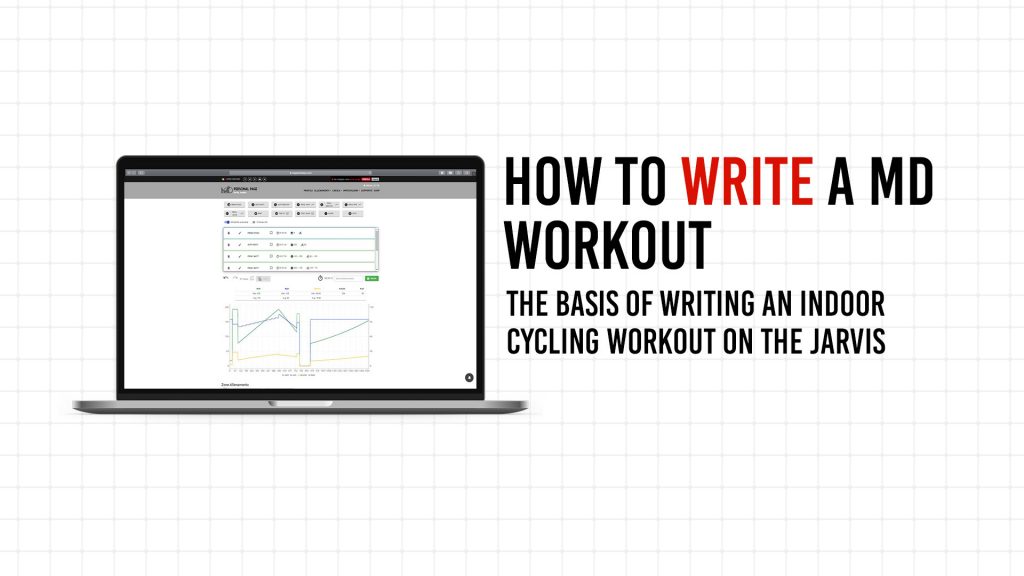
Writing workouts in “Framework Training” mode
Framework training mode – after having purchased the plug-in on the our website- allows you to do the following steps:
- IDEAL RYTHMS – work step where the Watts is calibrated based on the set RPM (if you change the RPM the Watts will change as well)
- SPRINT – lets you accelerate (increasing the revolutions) keeping the brake in a fixed position.
- HIIT SPRINT – SPRINT function implemented for the HIIT Training (High Intensity Interval Training)
And also talking about plug-in and writing capabilities, here is a list of steps that can be unblocked by purchasing the relative plug-in:
- NEWTON PROGRESSION – classic progression newton
- JOULE PROGRESSION – progression at constant work (by increasing the Watts the time will decrease)
- TEST PI – incremental power test (test 1:6)
- TEST JOULE – test incremental power at constant work
- STOP – this function is managed by the coach. During the recovery step the athlete should not move his legs (stop pedaling); the timer will keep going
On the occasion of the Italian Bike Festival a few days ago, several celebrities from the world of sports visited the MagneticDays stand to get together with the whole team and have a chat about indoor training, winter cycling preparation and seasonal events for 2020/2021. Among them was Alessandro Vanotti, Italian former professional cyclist with 9 Giri d’Italia, 5 Tour de France, 5 Vuelta de Espana and 1 World Championship, and today Coach and testimonial for MD. This gathering was an occasion to fine-tune the last details of the Vanotti Bicycle Camp 2020/2021: the project, dedicated to amateurs, offers the magic adventure of a professional team’s retreat on the road, combined with the experience of an active cycling vacation: “Training with quality is possible – said Vanotti – and this is what I try to transfer every day to all those who ride with me. That’s why I joined the MD family and this team; I saw a very high level both on the technical preparation and the human factor, two ingredients that will certainly bring value to my project.”
MD Coach Luca Bianchini – who will support Alessandro Vanotti during the camps – wanted to go into more detail about some aspects of the Vanotti Bicycle Camp. Here are some key points of their conversation.
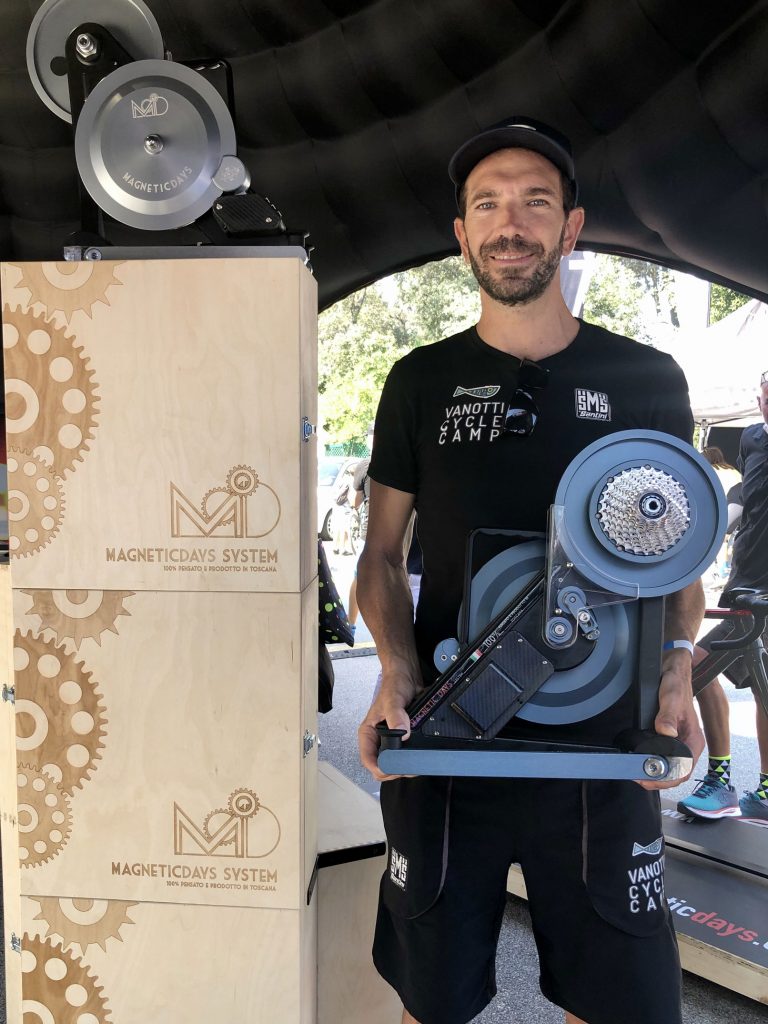 The Vanotti Bicycle Camp will start soon and I will come give you my support. How will the individual stages be organized?
The Vanotti Bicycle Camp will start soon and I will come give you my support. How will the individual stages be organized?
Your support and that of MagneticDays will be invaluable. In fact, you and I will welcome customers as MD staff and together we will evaluate their physical condition at that precise moment. The aim of this is building a work base for the following days by dividing the group according to each individual’s need and workload / volume. This will allow us to have excellent data to start from (Watt, Newton and specific RPM), so that we will be able to plan “perfect” road rides, that is to say calibrated, “tailored” rides. Thanks to MD, in fact, we have unbelievable data available right before starting the work with the group, who is therefore in the best condition to live a quality cycling experience.
So not just a division into a group based on one’s abilities but also aimed at the projection of the various paths to be structured?
Of course. Based on the data that we will collect during the incremental test, we will have both the possibility of arranging two types of routes or of riding the same route in two different groups according to current condition of the participants. This in order to ensure everyone can have fun, stay together and finish the course in an optimal manner and be satisfied with the work done. Furthermore, I will be present and up close in all the outings to give technical suggestions, and help everyone improve their riding. This is because everyone is different and has a distinctive response, and the goal is to work well, grow together and team up, just like in a real professional team.
What do you want athletes to bring home after having lived your bicycle camp?
First of all a unique experience, where everyone feels part of a real team and feels a bit like a professional athlete. I don’t mean in terms of performance, but in terms of approach to the type of work behind, for example, a World Tour team that comes together to prepare a great competition.
Cycling, especially today, is not just pedaling but much more. What’s your point of view?
I agree. The Vanotti Bicycle camp’s objective is the 360-degree cyclist, considered not individually but within a team. Your support at the camp will be precisely for this reason, with specific evening training sessions dedicated to the MagneticDays indoor personalized training methodology. In addition to passion, we try to give something more with gatherings dedicated to training, in this specific case thanks to your experience as an MD Coach. The ultimate goal is to be able to accurately capture all the needs of the group regarding the day spent together. Vanotti Bicycle Camp together with MagneticDays are the difference that makes the difference!
The MagneticDays Head Coach Simone Buracchi introduces another one fundamental cycling exercise of HTT Methodology of Training: HOW TO STIMULATE THE ANAEROBIC THRESHOLD WITH A MD WORKOUT.
“In today’s technical pill, our focus is on two Newton-controlled steps, both lasting 3 minutes and with the same goal: the stimulation of the anaerobic threshold developing the same value of Watts, but in 2 different ways. In the first case (red circle) we are facing a step in agility where the value of newtons are those of the athlete’s threshold but the number of RPM is increased than those at the threshold (93 instead of 90), with the stimulation of the cardio-respiratory system. In the second step of workout (yellow circle) we are facing the opposite situation; the number of RPM at the threshold are the same (90) but the value of the newton increases, with the muscular strenght development.”
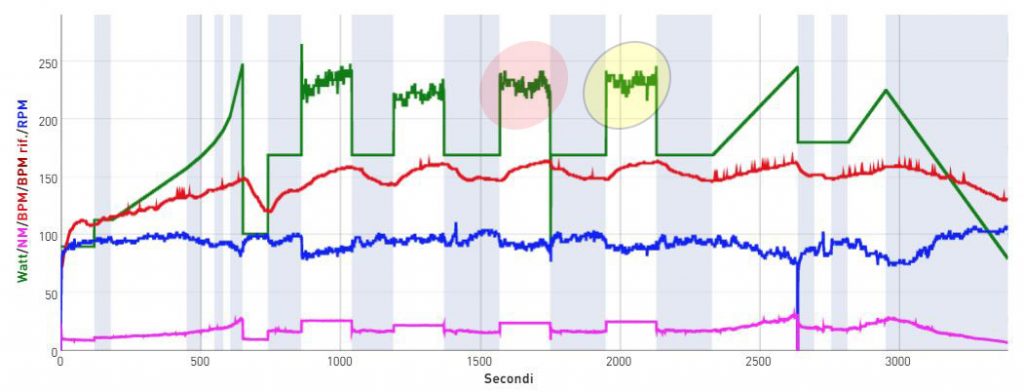
A few weeks ago we introduced a small change within the MagneticDays AUTOTESTS. But first, let’s remind us all what AUTOTESTS are: autotests or self-tests are incremental test protocols available (free of charge) to all MD customers/users who own an account on our site. They are used to choose the best range of physiological parameters when it comes to writing a workout or riding a Self-Managed Workouts, or simply to know the fitness level after a period of inactivity.
Each MagneticDays AUTOTEST (seven in total) corresponds to an assumed threshold level (processed by an algorithm) and, for each one, both the warm-up and the start of the incremental test will change. What does the change consist of? Until recently, the athlete’s recovery was an active recovery, meaning that after reaching the maximum bearable wattage, the brake opened to give the possibility to recover by pedaling. From today, however, the recovery is passive (yellow area of the graph below), meaning that the athlete recovers “from a standstill” for the entire duration, which is decided by the MD Coach. We defined this as the recovery index, or the ability of the heart to reduce the heart rate at the end of an exercise. The speed with which the heart returns to a low frequency indicates the efficiency of the cardiovascular system. It is believed that the recovery index reflects the reactivation balance of the parasympathetic nervous system and the inhibition of the sympathetic nervous system[1].
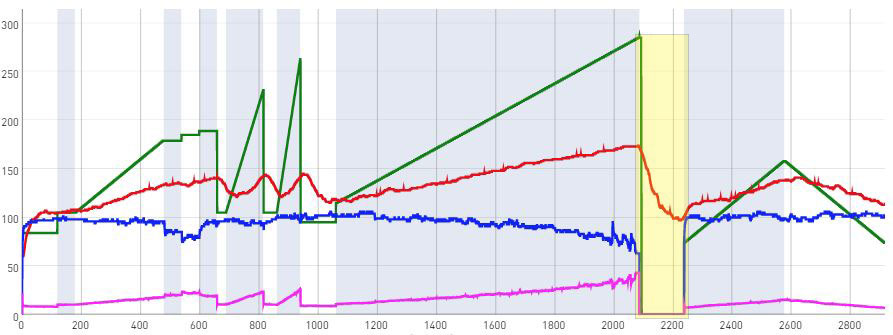
Cells need to rebuild ATP during recovery
It is necessary for cells to rebuild ATP (Adenosine triphosphate) after exertion, and this process takes place during recovery. In the first 10 seconds this is done by the anaerobic alactacid system (the re-synthesis of ATP by means of the creatine phosphate kinase enzyme). Subsequently – up to about 30 seconds – the anaerobic lactacid system is activated (splitting of glucose with production of ATP and lactic acid). From 30 seconds on, the aerobic system is more involved in the recovery.
The three recovery indexes (IDR), described in the report that the MagneticDays Coach sends to the athlete after each training block, indicate the efficiency of the energy systems at the end of a maximum effort, such as an incremental power test. In addition, they indicate the athlete’s resilience in the three areas as well as in general. This allows the MD Coach to calibrate each customized indoor training session, with the relative recoveries studied ad hoc.
The recovery indexes in the MagneticDays report
The recovery indexes highlighted in the MagneticDays report are:
- IRD AA: Anaerobic Alactic Recovery Index, or the ability to resynthesize ATP through the use of the enzyme creatine phosphate kinase (CPK);
- IDR AL: Anaerobic Lactacid Recovery Index, or the ability to resynthesize ATP through the use of anaerobic glycolysis;
- IDR AE: Aerobic Recovery Index, or the ability to resynthesize ATP through the use of the Krebs Cycle;
- IDR GENERAL: GENERAL Recovery Index, or the ability to resynthesize ATP through the use of all three systems.
How to read the recovery index
To read the recovery index, the following must be kept in mind: the number indicated in the report corresponds to the slope of the linear regression line intercepted through the points examined by the MD Coach. A low number corresponds to a poor recovery capacity, conversely, a high number means the athlete has a good recovery capacity. The numbers taken individually are not very useful. To understand whether the personalized indoor training has achieved its effects, it is necessary to compare them with the parameters of a subsequent incremental test. And this is one of the many advantages of the MagneticDays coaching service.
Screen Mirroring is a modality of connection that allows you to switch the App MD WiFi that’s playing on your smaller Android or Apple device to a larger one for a better viewing experience. Here’s how to connect your smartphone or tablet to a monitor or TV (NO PC!) and via HDMI cable. Screen mirroring will help you to view the screen of App MD WiFi in the best way. Are u ready for an incredible training mode with JARVIS smart trainer?
WE’RE BACK!
We’re back to work today after 2 months in smart working. During this time we did our best to make you feel less sad. We are full of enthusiasm and gratitude, in total compliance with the rules for the phase two of this coronavirus pandemic. The sun is shining in Val di Chiana and we wish you all the best. We are here. We have always been there. And we’ll be there every day.
MagneticDays continues to look to the future with hope, optimism and a great desire to start again, perfectly aware to be a resilient family-run business and innovative brand in the same time, constituted by a resistant group of people capable of coping with the unexpected with ingenuity and creativity.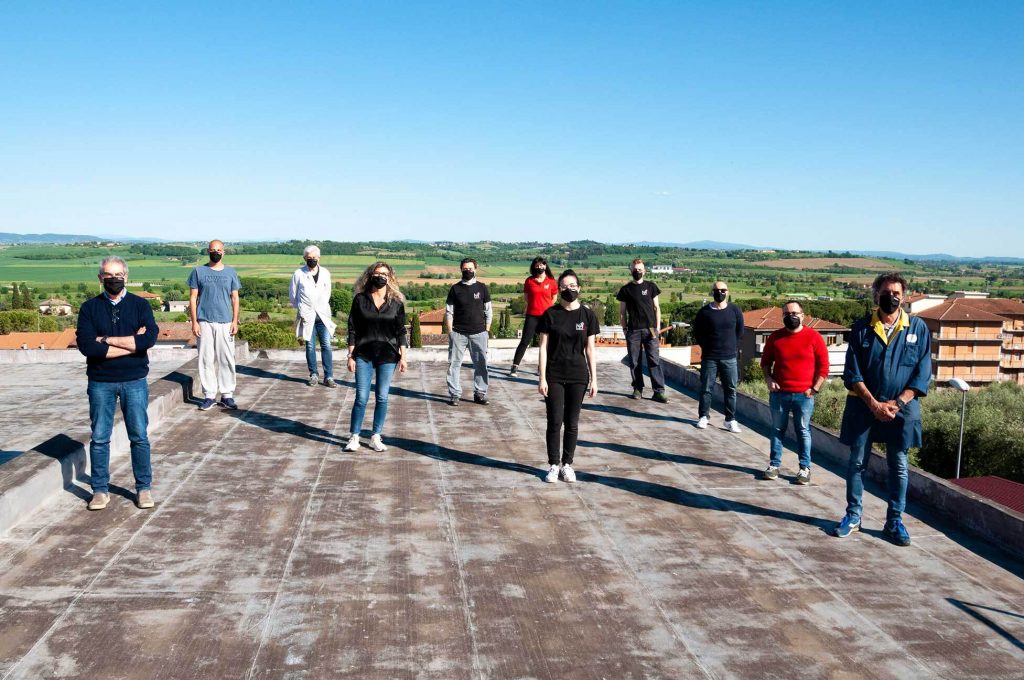
The new firmware update about the compatibility with Bluetooth FTMS protocol is available now on App section of our website. Directions are following.
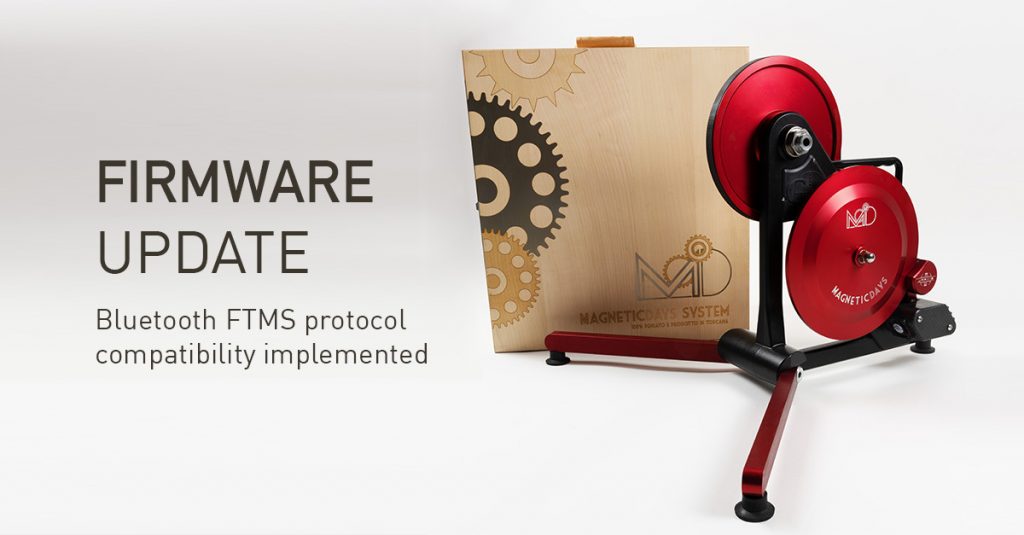
BEFORE
- JARVIS is compatible with Bluetooh FTMS (only with Zwift and only for iPhone/iPad);
- 4-25 e 6-30 ARE NOT COMPATIBLE with Bluetooth FTMS.
NOW
- JARVIS is compatible with Bluetooth FTMS and all cycling platforms (except Rouvy AR at the moment), for Android and iOS;
- 4-25 e 6-30 ARE NOT COMPATIBLE with Bluetooth FTMS.
FUTURE STEP
- Compatibility with Bluetooth FTMS for all cycling platforms and 4-25 e 6-30 trainers also, for Android and iOS.
Going fast uphill is one of the goals of many cycling, mountain bike and triathlon enthusiasts. The recent lockdown has presented many concerns to all athletes struggling to both keep fit and not lose all the hard work done until the end of February. In the run-up to phase 2, one of the most frequently asked question was: “Will I be able to go uphill as fast as before”?
My answer, short and reassuring, has always been: “Of course, actually, you will go faster”! “But how can I go fast uphill if I don’t pedal uphill”? More often than not was the reply! At this point, I want to share some principles of Physics by providing a detailed answer.
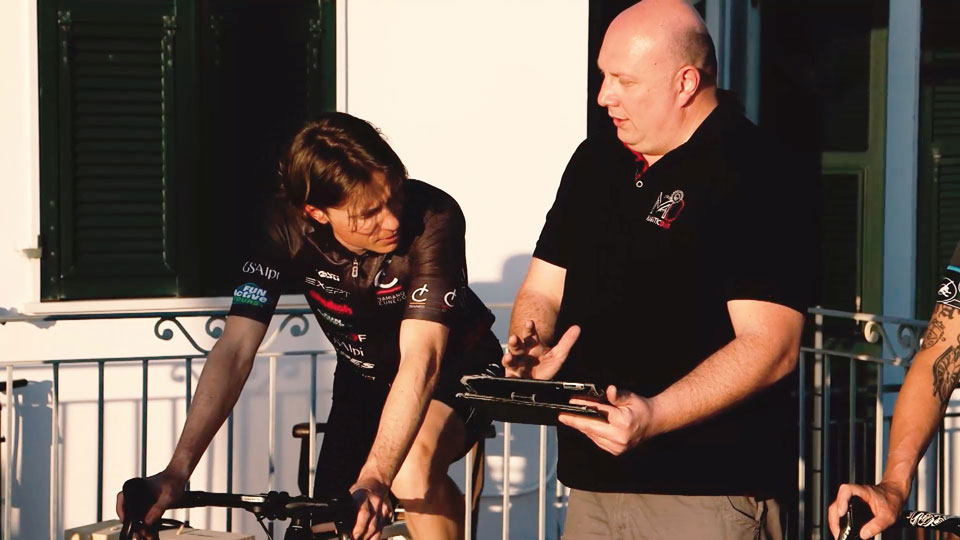
Let’s assume we have an athlete weighing 70 kg and a 7 kg bicycle with an additional 2.2 kg of weight between clothes and water bottles. Uphill, at a speed of 30 km/h, we estimate about 195 Watts. These Watts are used to overcome the resistances (front section, friction and slope being the main ones) and to maintain speed. At the same speed (30 km/h) – with a gradient of 1% – we must supply 261 Watts; at 2% 327 Watts, at 3% 293 Watts. If we want to keep the power constant of about 200 Watts, we must adjust the speed: with a gradient of 1% we will go 26 km/h, 2% 23 km/h, 3% 19.5 km/h. As we can see from these simple calculations, for the same wattage the speed must necessarily change. As previously stated, the three main factors that influence the forward movement are:
a) front section (also called drag), which increases proportionally to the speed;
b) force of gravity (which increases as the slope increases);
c) friction such as that generated by old bearings, deflated wheels or a dirty chain.
In the following table I summarized the numbers shown above with the addition of the gravity and drag factors.
| Slope
(%) |
Speed
(Km/h) |
Power
(Watt) |
Gravity
(% of the total) |
Drag
(% of the total) |
Other
(% of the total) |
| 0 % | 30 | 195 | 0 | 81 | 19 |
| 1 % | 26 | 191 | 30 | 54 | 16 |
| 2 % | 23 | 200 | 50 | 36 | 14 |
| 3 % | 19,5 | 194 | 65 | 23 | 12 |
As you can see, as the slope increases, the influence of gravity increases, while the drag decreases as speed decreases. The 3% gradient is an easily cycled climb for many cyclists. I used the weight of same person (plus gear) as an example, as we know the overall weight of the “cyclist-bicycle-clothes” system affects the weight/power ratio.
Now, going back to the initial question “how to go faster uphill”, there are many recommendations that can be found online, from technical tips to training with various repetitions. However, all these tips have one thing in common: to go fast uphill you need to increase your threshold power.
In normal conditions, in fact, we would do a long uphill at the intensity of the fondo medio, which we know is around 80% of our FTP. If we take our cyclist as an example, he should have a threshold of about 250 Watts. Using a bit of logical reasoning, if we increase the power of the anaerobic threshold by 5%, we go to 262 Watts, which is 210 Watts at 80%. In terms of speed, we are at 20.5 km/h at 3%, that is 1 kilometer per hour more compared to the previous condition. We have improved!
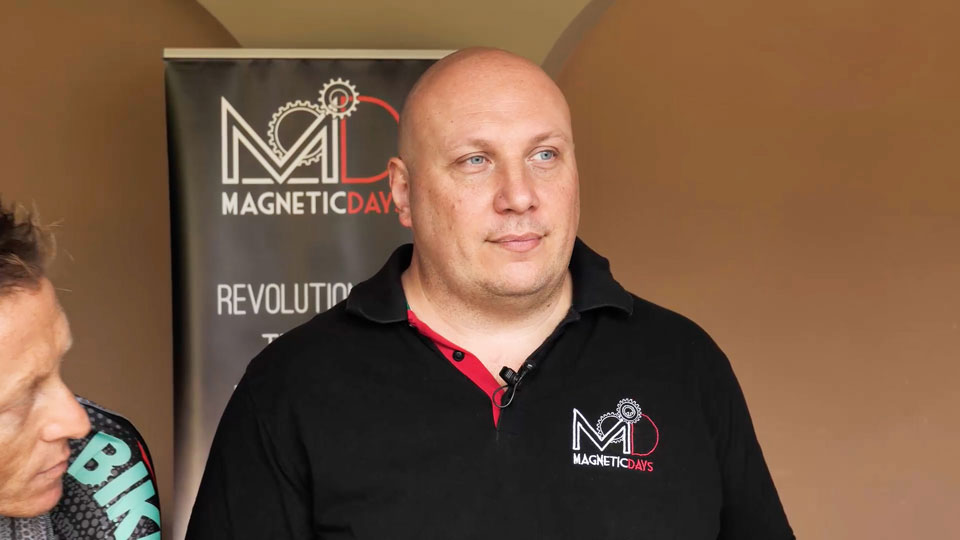
We always need to keep in mind that 200 Watts uphill or 200 Watts on a flat surface are the same. What changes is the speed. So, the opening question should be: “Does it make sense to train uphill to go fast uphill”? I suppose the answer is starting to be clear, but let’s make another consideration. When training with repetitions uphill, you can do shorter or longer repetitions. The intensity will decrease proportionally to the duration of the repetition. When you go below the threshold, the training stimulus is no longer aimed at increasing the threshold power but at being able to last longer. This is also a useful and necessary factor, but performing “al medio” will not reduce your climbing time at all.
To stimulate the body to increase the threshold it is necessary to provide stimuli around and beyond the threshold power, as we do for example at MagneticDays through the customized HTT training methodology expressed on JARVIS smart trainers. The question I ask you now – considering what has been said – is: “Is it therefore possible to go fast uphill with indoor training”? In indoor training we have 8+1 advantages that help us work on improving FTP. Let’s see them in detail:
- We exclude the limiting factors of performance (force of gravity, drag and various frictions);
- We have an optimal biomechanical efficiency;
- We exclude stopwatches, tables to follow and ideal routes to look for;
- We calibrate the intensities according to our abilities;
- We avoid U-turns in curves and crazy descents to get back into recovery time;
- We have the constant supply of working power and the consequent optimization of the cadence;
- We have the optimization of training times;
- We challenge our teammates on Sunday instead of thinking about repetitions;
- HTT protocols are personalized workouts aimed at improving performance and well-being.
In conclusion, I ask you: “Do you have to go uphill to go uphill”? Personally I am convinced that we must work on improving the individual performance, using an ideal training method and having patience and confidence for at least three weeks, which is the minimum time to appreciate the results. Then, if you want, nothing (but further lockdowns!) prevents you from getting on your bike and going to train uphill.
PS: The calculation of the weight / power ratio (the famous Watt/Kg of body weight), are included in the category “force of gravity”. When you are outdoors, it is MANDATORY to calculate the body weight of your clothes before going out and add it to the weight of the bicycle with full bottles. That is, in fact, the overall weight when riding outdoors. In indoor training, the force of gravity is zero, so you just need to do the division using your won weight, and nothing more.
In this historic moment, with the world pandemic and all the associated limitations, many people are dedicating more time to indoor cycling. Sports help you fill your days, strengthen your body and your mind, optimize your time and keep yourself in good health. However, some people are beginning to show signs of impatience with the restrictions, and this impatience also turns into a hyperkinesia (an increase in muscular activity that can result in excessive normal or abnormal movements) in terms of training. It is known that sport is addictive and doing without it for a long period of time causes side effects comparable to the ones due to abstinence from substances such as tobacco. The healthy remedy, therefore, is to continue to practice sports, without “overreaching”. Overreaching is what scientists define as an “accumulation of stimuli, whether from training or not, which results in a short-term decrease in performance, with or without signs or related symptoms (physiological or psychological) of a poor adaptation, and where the recovery of performance can take several days or weeks.”
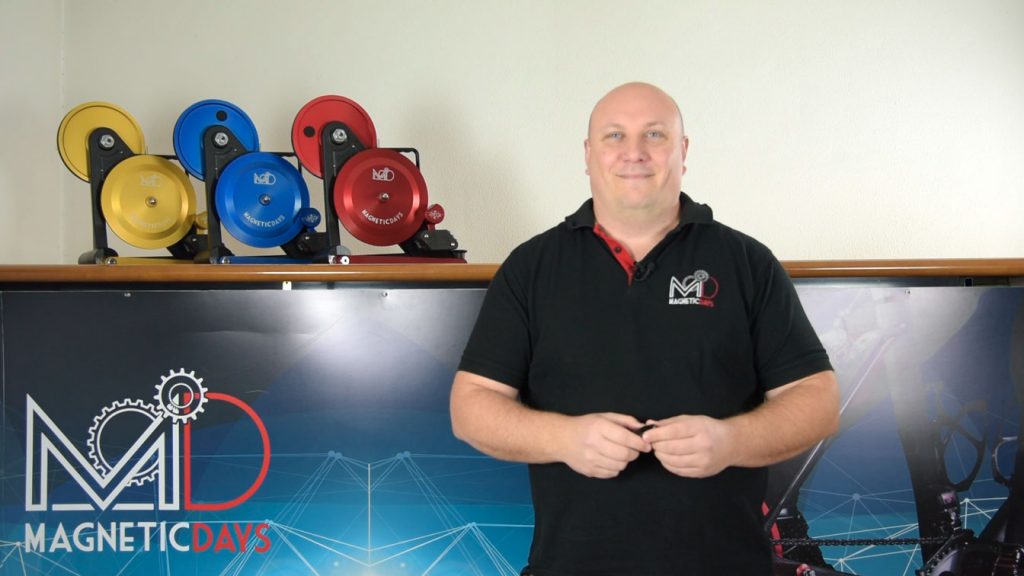
MagneticDays Coach Luca Bianchini offers us an interesting food for thought: “If in a normal day physical activity covers a part of the time, in this particular period in history the percentage of that time increases. The risks produced by an increase in physical activity at home are sometimes unpleasant. The intensity of indoor cycling is certainly greater than the outdoor one and this implies longer recovery times. Excessive sweating leads to a state of chronic dehydration that must necessarily be compensated for. The return to homeostasis is sometimes longer than normal. The first discomforts that are being observed due to the increase in physical activity are latent – continues Coach Bianchini – but they do not go unnoticed to a careful eye. If we used to train 3 or 4 times a week, now we train 7 days a week. Our body is not used to keeping up this rhythm and responds with fatigue. The first organ to give us a signal of this state is the heart. Heart rate struggles to drop adequately during the recovery phase, and stays high even during rest. In maximal efforts, then, it struggles to reach the usual peaks. This is where the use of a valuable tool comes into play: a heart rate monitor. The more advanced ones also provide cardiac variability, data that allows you to evaluate actual recovery. If paying attention to these tools is sometimes underestimated, the lack of serotonin can be stronger stimulant than common sense. If proper attention is not provided to recovery, many people will suffer from chronic overexertion at the end of this period. And this state is the prelude to overtraining, which is a real pathology.“
How to avoid overreaching
Expanding on what Coach Luca Bianchini just talked about, how can you avoid overreaching? And what are the recommended practices? “First of all – continues Coach Bianchini – the variety of training loads: at each high-intensity workout it is necessary to alternate two recovery workouts, in which the heart rate or the reference watts remain under the indications of zone 2 or below 70% of the heart rate threshold. Furthermore, drinking more water than usual, not all at once, but increasing the consumption by at least half a liter (even a liter) throughout the day, is recommended. The body needs water, not only during the indoor cycling session, but also immediately after, and it is even better to add a soluble preparation of salts (magnesium and potassium) and essential amino acids. It is also advisable to take the same supplements right before bedtime, to prevent the onset of nocturnal cramps. It might seem obvious and outdated, but I feel the need to reiterate a concept that I really care about: it is precisely during rest that improvements occur, not during training. Recovery is just as important as training, if not more. Following the instructions of a coach is essential to ensure the correct management of training during the week. If we want to reach the competitive season in the best shape possible, we need to use our head, not only our legs.”










